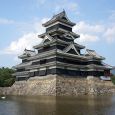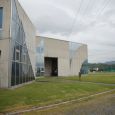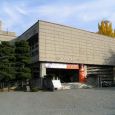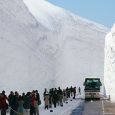Matsumoto
Advertisement
By plane
Matsumoto has a small local airport, with commercial flights only from Osaka, Sapporo, and Fukuoka. Travel time to downtown is roughly 20 minutes.
From the closest major airport, Chubu Centrair International Airport near Nagoya, Matsumoto can be reached by rail in roughly three hours by the Meitetsu line and JR limited express train (change in Nagoya). Buses connect Centrair with Matsumoto in around 3 1/2 to 4 hours for ¥3500.
From Narita Airport, Matsumoto can be reached in 4 1/2 to 5 hours by limited express rail service (change in Shinjuku).
By train
Matsumoto is located on the JR Shinonoi Line. It is four stops away from Shiojiri, the "mid-point" of the Chuo Main Line between Tokyo and Nagoya. There is a tourist information center inside the train station.
Limited express trains run to Matsumoto from Tokyo's Shinjuku station. The Super Azusa makes the run in about 2 1/2 hours; the Azusa makes the journey in about three hours (¥6710 for both).
By bus
Highway buses from JR Matsumoto station connect to Shinjuku in Tokyo (3 hours, ¥3400), Nagoya (3 1/4 hours, ¥3460), and various destinations in the Japan Alps, notably the Oku-Hida Onsen Villages (90 min, ¥2300-2800).
Advertisement
Matsumoto Castle
Matsumoto Castle is one of the most complete and beautiful among Japan's original castles. It is also a good example of a so called "hirajiro", a castle built on the plain rather than on a hill or mountain.
Matsumotojo's castle tower and smaller, second turret were built from 1592 to 1614 and were both well defended, as peace was not yet fully secured at the time. In 1635, when no more military threats existed, a third, barely defended turret for moon viewing was added to the castle.
Japan Ukiyoe Museum
The Japan Ukiyoe Museum exhibits ukiyoe (woodblock prints) from the vast collection of the Sakai family.
One of Matsumoto's wealthiest merchants of his time, Sakai Yoshiaki started collecting ukiyoe and other pieces of art roughly 300 years ago. His descendants have been enlarging the collection to over 100,000 pieces, making it one of the world's largest private art collections.
Compared to the size of the collection and the museum building, the number of works exhibited in the Japan Ukiyoe Museum is rather small, partly due to the fact that the building was originally built solely for storage rather than exhibition purposes. English descriptions for the exhibits are brief.
Tateyama Kurobe Alpine Route
The Tateyama Kurobe Alpine Route is a unique and spectacular route through the Northern Japan Alps, which is traversed by various means of transportation, including cablecars, trolley buses and a ropeway. The route is particularly famous for the high snow walls that line some of its roads in spring.
The Tateyama Kurobe Alpine Route was completed in 1971, and connects Toyama City in Toyama Prefecture with Omachi Town in Nagano Prefecture. The section between Tateyama Station and Ogizawa is closed to private vehicles.
The route is open from mid April through November. In 2011, the entire route is open from April 16 to November 30. The snow corridor in Murodo is open to pedestrians to walk from April 16 to May 31. On the opening day, the snow wall reached a height of up to 17 meters.
The Matsumoto Folkcraft Museum
This is a very small museum filled with a variety of arts and crafts that the museum's own pamphlet describes as not being of much value either artistically or monetarily. The museum is basically the collection of a private individual, Taro Maruyama, who ran a folkcraft shop in Matsumoto in the 1950 and 1960s. He presented the museum to the city of Matsumoto in 1983. While some of the crafts and artwork are interesting, the museum is probably not worth visiting unless you are spending a considerable amount of time in the vicinity or are particularly interested in Japanese Folkcrafts. (On an interesting side note, a home near the museum, owned by a school principal, has a beautiful garden and is quite pretty, employing some traditional Japanese architecture. Our tour guide said many people found the home of more interest than the museum.) Admission is ¥300 for adults. School children can get in for free and the museum offers group rates for groups over 20. Hours: 9:00 am to 5:00 pm Tuesday through Sunday. The museum is also closed from December 29 through January 3. You can take the bus on the Utsukushigahara line for 15 minutes and get off that the Folkcraft Museum bus stop.
April - November
Information not available
Advertisement







